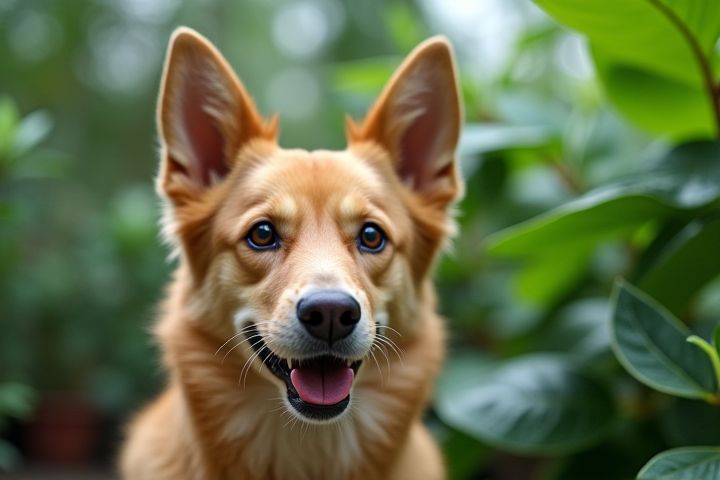
Certain houseplants can pose toxicity risks to pets, including cats and dogs. Common toxic plants include Philodendron, which can cause oral irritation, vomiting, and difficulty swallowing if ingested. Oleander contains cardiac glycosides, potentially leading to heart issues and gastrointestinal distress for your furry friends. Lilies, particularly true lilies, are extremely harmful to cats, causing kidney failure even with a small amount. If you are a pet owner, it's vital to research plant safety and choose non-toxic alternatives, such as spider plants or bamboo palms, to create a safe indoor environment.
Which House Plants Are Toxic To Pets
Lilies
Lilies, particularly the Easter lily, Tiger lily, and Asian lily, are highly toxic to pets, especially cats. Ingesting even small amounts of these plants can lead to severe kidney damage in felines. Symptoms of lily poisoning may include vomiting, loss of appetite, lethargy, and increased thirst or urination. To keep your furry friends safe, it's essential to avoid having lilies in your home if you have pets.
Philodendron
Philodendron is a popular houseplant known for its lush foliage and easy care, but it is toxic to pets, particularly cats and dogs. The plant contains insoluble oxalate crystals, which can cause irritation in the mouth and throat, leading to symptoms such as drooling, vomiting, and difficulty swallowing. If your pet ingests Philodendron, it's essential to seek veterinary attention promptly to manage any adverse reactions. To ensure the safety of your furry friends, consider placing this plant in areas that are inaccessible or choose pet-friendly alternatives for your indoor garden.
Pothos
Pothos, scientifically known as Epipremnum aureum, is a popular houseplant but is toxic to pets, particularly cats and dogs. The plant contains insoluble calcium oxalates, which can cause irritation to the mouth, throat, and gastrointestinal tract if ingested. Symptoms of poisoning may include vomiting, drooling, and difficulty swallowing, so it's crucial for pet owners to keep Pothos out of reach of curious animals. If you suspect your pet has ingested any part of the Pothos plant, contacting a veterinarian immediately is advisable for proper assessment and treatment.
Dieffenbachia
Dieffenbachia, commonly known as dumb cane, is a popular houseplant notable for its lush green leaves and striking variegation; however, it is toxic to pets, particularly cats and dogs. The plant contains calcium oxalate crystals, which can cause severe oral irritations, swelling of the mouth and throat, and difficulty swallowing if ingested. Symptoms of Dieffenbachia poisoning in pets may include drooling, vomiting, and decreased appetite, necessitating immediate veterinary attention. If you have pets, consider placing this plant out of their reach or exploring pet-safe plant alternatives to ensure their well-being.
Sago Palm
Sago Palm (Cycas revoluta) is highly toxic to pets, particularly to dogs and cats, due to the presence of toxins called cycasin. Ingesting any part of the plant can lead to severe symptoms such as vomiting, diarrhea, seizures, and potentially fatal liver failure. Even small amounts can be harmful, so it's crucial to keep Sago Palms out of reach of your pets. If you suspect your pet has ingested Sago Palm, immediate veterinary attention is essential to ensure their safety and well-being.
Oleander
Oleander, known scientifically as Nerium oleander, is highly toxic to pets, particularly cats and dogs. Ingesting even small amounts can lead to serious health issues, including gastrointestinal distress, heart problems, and potentially death. Symptoms of oleander poisoning may include vomiting, diarrhea, abnormal heart rates, and even seizures, requiring immediate veterinary attention. Always keep this beautiful yet dangerous plant out of your home if you have curious pets.
Caladium
Caladium, commonly known as elephant ear, is a beautiful houseplant admired for its vibrant foliage. However, it contains calcium oxalate crystals, making it toxic to pets such as cats and dogs if ingested. Symptoms of toxicity may include drooling, vomiting, and difficulty swallowing, which can cause discomfort for your furry friends. To keep your pets safe, consider placing Caladium out of reach or selecting non-toxic houseplants for your home.
Aloe Vera
Aloe Vera, while often praised for its medicinal properties, is toxic to pets, particularly cats and dogs. The plant contains saponins and anthraquinones, which can result in vomiting, diarrhea, and abdominal pain if ingested by your furry friends. Symptoms of Aloe Vera poisoning may include lethargy, tremors, and changes in urine color. It's essential to keep Aloe Vera out of reach of pets or opt for pet-safe alternatives to ensure their health and safety.
Peace Lily
The Peace Lily (Spathiphyllum) is a popular houseplant known for its attractive white flowers and lush green leaves, but it's important to recognize that it can be toxic to pets, particularly cats and dogs. When ingested, the Peace Lily contains calcium oxalate crystals that may cause oral irritation, drooling, vomiting, and difficulty swallowing in animals. Symptoms can appear within minutes to hours after ingestion, highlighting the need for pet owners to place this plant out of reach of curious pets. If you suspect your pet has consumed any part of a Peace Lily, consulting a veterinarian promptly is crucial for appropriate care.
Snake Plant
The Snake Plant (Sansevieria trifasciata), commonly found in homes for its hardy nature and air-purifying qualities, is toxic to pets, particularly cats and dogs. Ingesting this plant can lead to gastrointestinal issues, including nausea, vomiting, and diarrhea due to the presence of saponins. Symptoms may appear within hours of consumption, making it crucial for pet owners to monitor their fur babies around this popular indoor plant. If you suspect your pet has ingested Snake Plant foliage, contacting a veterinarian immediately is vital to ensure their health and safety.
